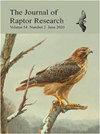Abundance and Breeding Ecology of Critically Endangered Vultures in Mole National Park, Ghana
IF 1.2
4区 生物学
Q2 ORNITHOLOGY
引用次数: 0
Abstract
Vultures are among the most threatened species in Africa, with several critically endangered species surviving mainly or only in protected areas. West African vulture declines are correlated with steep losses of natural habitat and mammalian wildlife. Major factors driving vulture extirpations include wildlife trade for traditional medicine, belief-based rituals, and bushmeat. Current data on vulture abundance and breeding ecology are crucial for conservation but lacking in many countries, including Ghana. Between 2020 and 2022, we conducted 761 km of surveys for critically endangered vultures in Mole National Park (Mole NP), a 4840 km2 protected savanna in northern Ghana. Using our count data, we estimated populations of 29–36 Hooded Vultures (Necrosyrtes monachus), 25–73 White-backed Vultures (Gyps africanus), and 3–4 White-headed Vultures (Trigonoceps occipitalis) in the southern region of Mole NP. We also documented 17 occupied vulture nests, including six Hooded Vulture nests, 10 White-backed Vulture nests, and one White-headed Vulture nest. Our findings include the first nest records for Hooded Vultures in Mole NP, the first nest description of White-backed Vultures in Ghana, and the first nest records for White-headed Vultures in Ghana, confirming the importance of Mole NP for conserving critically endangered vultures. Reducing poaching, preventing the killing of vultures for wildlife trade, and protecting vulture habitat and food resources will be paramount to the survival of critically endangered vultures in Ghana and West Africa.加纳摩尔国家公园极度濒危秃鹫的数量和繁殖生态学
秃鹫是非洲最受威胁的物种之一,有几个极度濒危的物种主要或只生活在保护区。西非秃鹫数量的减少与自然栖息地和野生哺乳动物的急剧减少有关。导致秃鹫灭绝的主要因素包括传统药物、基于信仰的仪式和丛林肉的野生动物贸易。目前关于秃鹫数量和繁殖生态的数据对保护秃鹫至关重要,但包括加纳在内的许多国家都缺乏这些数据。在2020年至2022年期间,我们在加纳北部4840平方公里的热带稀树草原鼹鼠国家公园(Mole NP)对极度濒危的秃鹫进行了761公里的调查。利用我们的计数数据,我们估计了在鼹鼠NP南部地区有29-36只帽秃鹫(necrosytes monachus), 25-73只白背秃鹫(Gyps africanus)和3-4只白头秃鹫(Trigonoceps occipitalis)。我们还记录了17个被占用的秃鹫巢,包括6个连帽秃鹫巢,10个白背秃鹫巢和一个白头秃鹫巢。我们的研究结果包括Mole NP的第一个秃鹫巢记录,加纳白背秃鹫的第一个巢描述,以及加纳白头秃鹫的第一个巢记录,证实了Mole NP对保护极度濒危秃鹫的重要性。减少偷猎,防止因野生动物贸易而杀害秃鹫,保护秃鹫栖息地和食物资源,对加纳和西非极度濒危的秃鹫的生存至关重要。
本文章由计算机程序翻译,如有差异,请以英文原文为准。
求助全文
约1分钟内获得全文
求助全文
来源期刊

Journal of Raptor Research
生物-鸟类学
CiteScore
2.30
自引率
17.60%
发文量
61
审稿时长
>12 weeks
期刊介绍:
The Journal of Raptor Research (JRR) is an international scientific journal dedicated entirely to the dissemination of information about birds of prey. Established in 1967, JRR has published peer-reviewed research on raptor ecology, behavior, life history, conservation, and techniques. JRR is available quarterly to members in electronic and paper format.
 求助内容:
求助内容: 应助结果提醒方式:
应助结果提醒方式:


